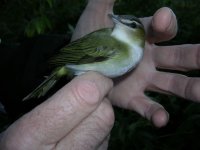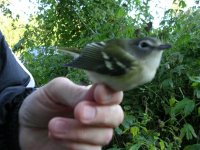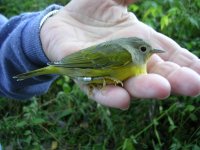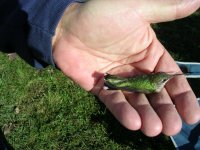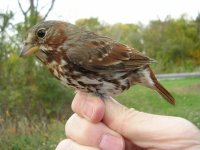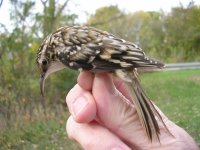Larry Lade
Moderator
Fall Bird Banding at Missouri Western State University (MWSU)
Jack, my bird banding friend, and I began banding birds a week or so ago on the campus of Missouri Western State University. This location is about four miles from where I live in Saint Joseph, Missouri, USA. Up until yesterday we had been having minimal success in netting and banding the birds. There just seemed to be only a few birds around. However, yesterday we succeeded in the capturing and banding of twenty-four birds. A fairly decent result from a couple of hours of early morning banding.
Nashville Warbler - 13
House Wren - 3
Gray Catbird - 1
Wilson's Warbler - 1
Common Yellowthroat - 1
Least Flycatcher - 1
Black-capped Chickadee - 1
Mourning Warbler - 1
Red-eyed Vireo - 1
Indigo Bunting - 1
Today (September 15, 2005) We banded at the above location for about 45 minutes between rain showers.
Least Flycatcher - 2
Gray Catbird - 1
"Trail's" Flycatcher (Alder/Willow complex) - 1
Wilson's Warbler - 1
House Wren - 1
Nashville Warbler - 3
Orange-crowned Warbler - 1
*plus one recapture of a Mourning Warbler (just banded a few days ago).
We are hoping for a southern push of migrants in the next few weeks. More species of warblers, vireos, kinglets and then the various native sparrow would be expected. Of course, we do net and band some of the resident species when they are captured in the nets.
Jack, my bird banding friend, and I began banding birds a week or so ago on the campus of Missouri Western State University. This location is about four miles from where I live in Saint Joseph, Missouri, USA. Up until yesterday we had been having minimal success in netting and banding the birds. There just seemed to be only a few birds around. However, yesterday we succeeded in the capturing and banding of twenty-four birds. A fairly decent result from a couple of hours of early morning banding.
Nashville Warbler - 13
House Wren - 3
Gray Catbird - 1
Wilson's Warbler - 1
Common Yellowthroat - 1
Least Flycatcher - 1
Black-capped Chickadee - 1
Mourning Warbler - 1
Red-eyed Vireo - 1
Indigo Bunting - 1
Today (September 15, 2005) We banded at the above location for about 45 minutes between rain showers.
Least Flycatcher - 2
Gray Catbird - 1
"Trail's" Flycatcher (Alder/Willow complex) - 1
Wilson's Warbler - 1
House Wren - 1
Nashville Warbler - 3
Orange-crowned Warbler - 1
*plus one recapture of a Mourning Warbler (just banded a few days ago).
We are hoping for a southern push of migrants in the next few weeks. More species of warblers, vireos, kinglets and then the various native sparrow would be expected. Of course, we do net and band some of the resident species when they are captured in the nets.
Last edited:




